Policy, Power, and Politics: An Analysis of Health Care Provision
VerifiedAdded on 2023/06/13
|8
|2287
|85
Essay
AI Summary
This essay explores the intricate relationship between policy, power, and politics in health care provision. It begins by justifying the policy cycle as an appropriate tool for developing new policies, highlighting its ability to streamline development, create timelines, and facilitate evaluation. The essay then differentiates between health policy and government policy documents, emphasizing the distinct focuses and origins of each. A comparison of the new and old public health approaches follows, noting the shift from broad population health to individual and preventative measures. Key sociological issues impacting health, such as resource availability and exposure to social disorder, are discussed. Finally, the essay outlines factors to consider when creating a smoke-free university policy, including management support, education, stakeholder involvement, risk communication, and resource provision for tobacco cessation. Desklib provides access to this and other solved assignments.
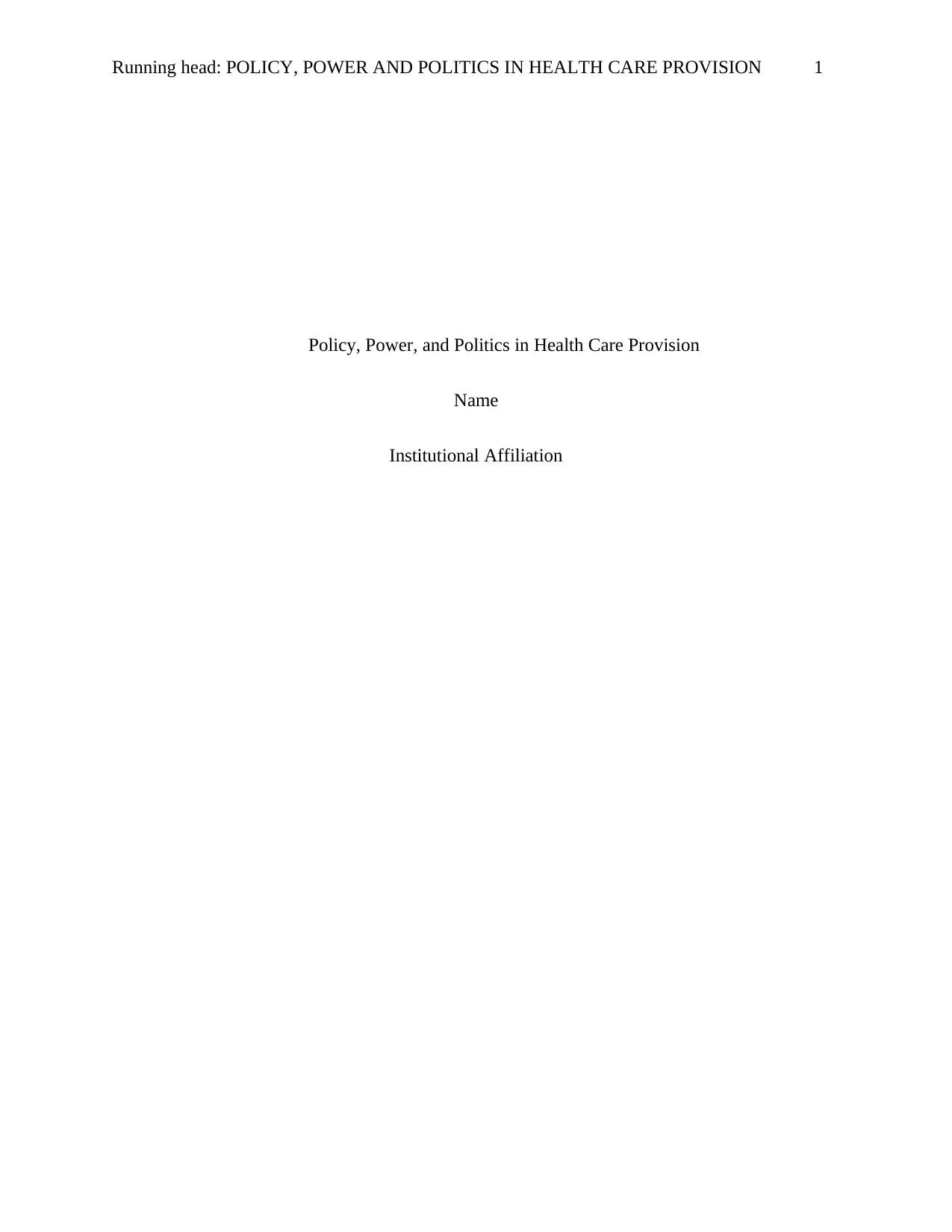
Running head: POLICY, POWER AND POLITICS IN HEALTH CARE PROVISION 1
Policy, Power, and Politics in Health Care Provision
Name
Institutional Affiliation
Policy, Power, and Politics in Health Care Provision
Name
Institutional Affiliation
Paraphrase This Document
Need a fresh take? Get an instant paraphrase of this document with our AI Paraphraser
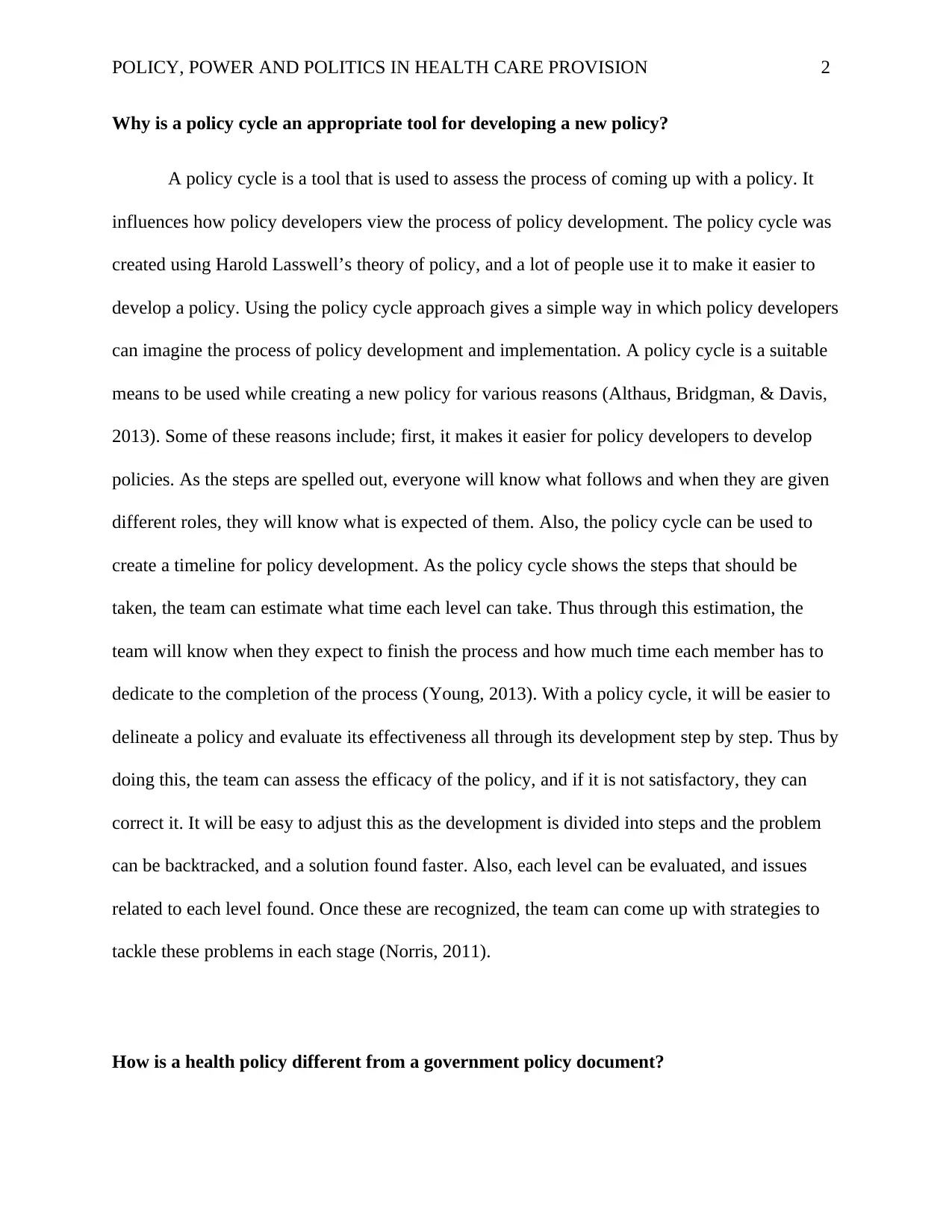
POLICY, POWER AND POLITICS IN HEALTH CARE PROVISION 2
Why is a policy cycle an appropriate tool for developing a new policy?
A policy cycle is a tool that is used to assess the process of coming up with a policy. It
influences how policy developers view the process of policy development. The policy cycle was
created using Harold Lasswell’s theory of policy, and a lot of people use it to make it easier to
develop a policy. Using the policy cycle approach gives a simple way in which policy developers
can imagine the process of policy development and implementation. A policy cycle is a suitable
means to be used while creating a new policy for various reasons (Althaus, Bridgman, & Davis,
2013). Some of these reasons include; first, it makes it easier for policy developers to develop
policies. As the steps are spelled out, everyone will know what follows and when they are given
different roles, they will know what is expected of them. Also, the policy cycle can be used to
create a timeline for policy development. As the policy cycle shows the steps that should be
taken, the team can estimate what time each level can take. Thus through this estimation, the
team will know when they expect to finish the process and how much time each member has to
dedicate to the completion of the process (Young, 2013). With a policy cycle, it will be easier to
delineate a policy and evaluate its effectiveness all through its development step by step. Thus by
doing this, the team can assess the efficacy of the policy, and if it is not satisfactory, they can
correct it. It will be easy to adjust this as the development is divided into steps and the problem
can be backtracked, and a solution found faster. Also, each level can be evaluated, and issues
related to each level found. Once these are recognized, the team can come up with strategies to
tackle these problems in each stage (Norris, 2011).
How is a health policy different from a government policy document?
Why is a policy cycle an appropriate tool for developing a new policy?
A policy cycle is a tool that is used to assess the process of coming up with a policy. It
influences how policy developers view the process of policy development. The policy cycle was
created using Harold Lasswell’s theory of policy, and a lot of people use it to make it easier to
develop a policy. Using the policy cycle approach gives a simple way in which policy developers
can imagine the process of policy development and implementation. A policy cycle is a suitable
means to be used while creating a new policy for various reasons (Althaus, Bridgman, & Davis,
2013). Some of these reasons include; first, it makes it easier for policy developers to develop
policies. As the steps are spelled out, everyone will know what follows and when they are given
different roles, they will know what is expected of them. Also, the policy cycle can be used to
create a timeline for policy development. As the policy cycle shows the steps that should be
taken, the team can estimate what time each level can take. Thus through this estimation, the
team will know when they expect to finish the process and how much time each member has to
dedicate to the completion of the process (Young, 2013). With a policy cycle, it will be easier to
delineate a policy and evaluate its effectiveness all through its development step by step. Thus by
doing this, the team can assess the efficacy of the policy, and if it is not satisfactory, they can
correct it. It will be easy to adjust this as the development is divided into steps and the problem
can be backtracked, and a solution found faster. Also, each level can be evaluated, and issues
related to each level found. Once these are recognized, the team can come up with strategies to
tackle these problems in each stage (Norris, 2011).
How is a health policy different from a government policy document?
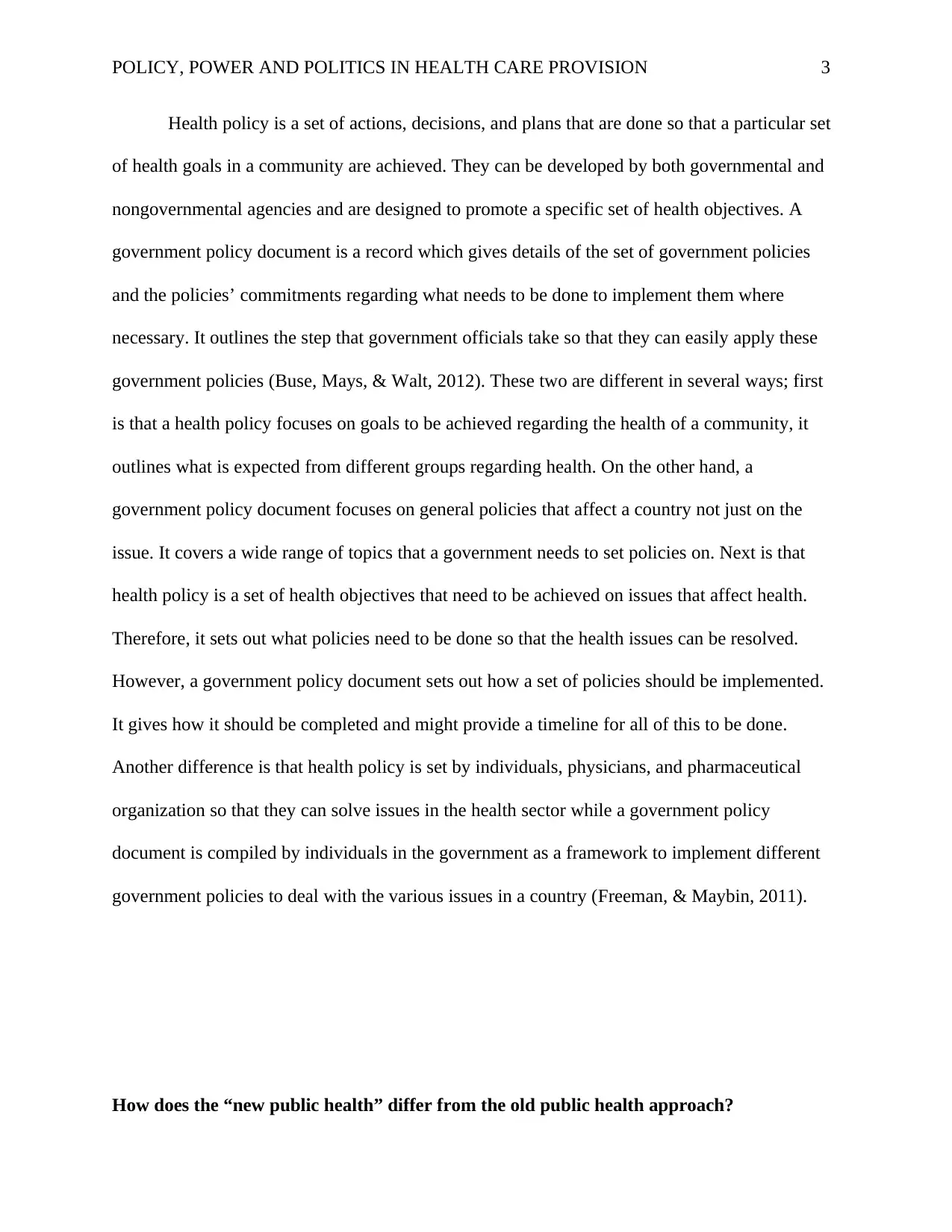
POLICY, POWER AND POLITICS IN HEALTH CARE PROVISION 3
Health policy is a set of actions, decisions, and plans that are done so that a particular set
of health goals in a community are achieved. They can be developed by both governmental and
nongovernmental agencies and are designed to promote a specific set of health objectives. A
government policy document is a record which gives details of the set of government policies
and the policies’ commitments regarding what needs to be done to implement them where
necessary. It outlines the step that government officials take so that they can easily apply these
government policies (Buse, Mays, & Walt, 2012). These two are different in several ways; first
is that a health policy focuses on goals to be achieved regarding the health of a community, it
outlines what is expected from different groups regarding health. On the other hand, a
government policy document focuses on general policies that affect a country not just on the
issue. It covers a wide range of topics that a government needs to set policies on. Next is that
health policy is a set of health objectives that need to be achieved on issues that affect health.
Therefore, it sets out what policies need to be done so that the health issues can be resolved.
However, a government policy document sets out how a set of policies should be implemented.
It gives how it should be completed and might provide a timeline for all of this to be done.
Another difference is that health policy is set by individuals, physicians, and pharmaceutical
organization so that they can solve issues in the health sector while a government policy
document is compiled by individuals in the government as a framework to implement different
government policies to deal with the various issues in a country (Freeman, & Maybin, 2011).
How does the “new public health” differ from the old public health approach?
Health policy is a set of actions, decisions, and plans that are done so that a particular set
of health goals in a community are achieved. They can be developed by both governmental and
nongovernmental agencies and are designed to promote a specific set of health objectives. A
government policy document is a record which gives details of the set of government policies
and the policies’ commitments regarding what needs to be done to implement them where
necessary. It outlines the step that government officials take so that they can easily apply these
government policies (Buse, Mays, & Walt, 2012). These two are different in several ways; first
is that a health policy focuses on goals to be achieved regarding the health of a community, it
outlines what is expected from different groups regarding health. On the other hand, a
government policy document focuses on general policies that affect a country not just on the
issue. It covers a wide range of topics that a government needs to set policies on. Next is that
health policy is a set of health objectives that need to be achieved on issues that affect health.
Therefore, it sets out what policies need to be done so that the health issues can be resolved.
However, a government policy document sets out how a set of policies should be implemented.
It gives how it should be completed and might provide a timeline for all of this to be done.
Another difference is that health policy is set by individuals, physicians, and pharmaceutical
organization so that they can solve issues in the health sector while a government policy
document is compiled by individuals in the government as a framework to implement different
government policies to deal with the various issues in a country (Freeman, & Maybin, 2011).
How does the “new public health” differ from the old public health approach?
⊘ This is a preview!⊘
Do you want full access?
Subscribe today to unlock all pages.

Trusted by 1+ million students worldwide
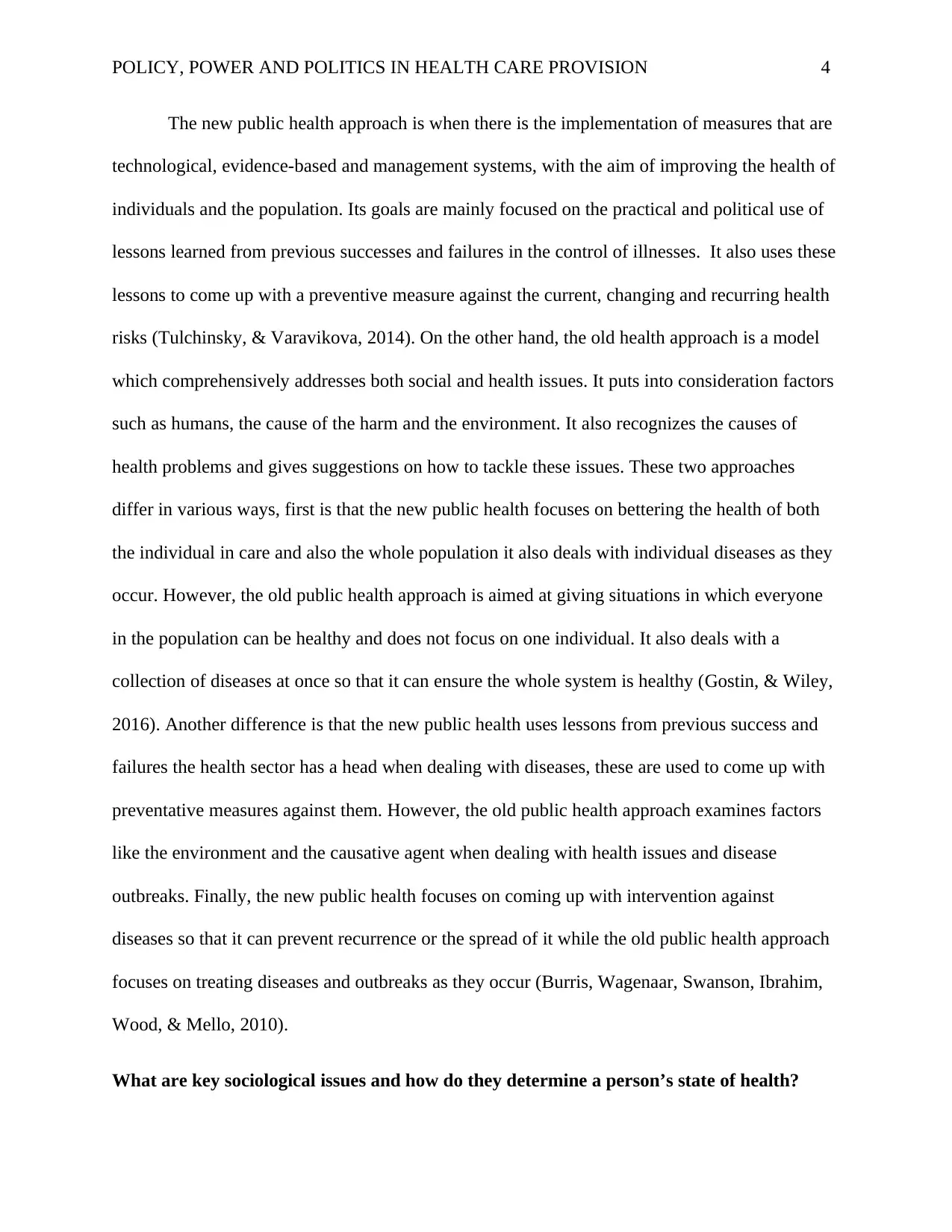
POLICY, POWER AND POLITICS IN HEALTH CARE PROVISION 4
The new public health approach is when there is the implementation of measures that are
technological, evidence-based and management systems, with the aim of improving the health of
individuals and the population. Its goals are mainly focused on the practical and political use of
lessons learned from previous successes and failures in the control of illnesses. It also uses these
lessons to come up with a preventive measure against the current, changing and recurring health
risks (Tulchinsky, & Varavikova, 2014). On the other hand, the old health approach is a model
which comprehensively addresses both social and health issues. It puts into consideration factors
such as humans, the cause of the harm and the environment. It also recognizes the causes of
health problems and gives suggestions on how to tackle these issues. These two approaches
differ in various ways, first is that the new public health focuses on bettering the health of both
the individual in care and also the whole population it also deals with individual diseases as they
occur. However, the old public health approach is aimed at giving situations in which everyone
in the population can be healthy and does not focus on one individual. It also deals with a
collection of diseases at once so that it can ensure the whole system is healthy (Gostin, & Wiley,
2016). Another difference is that the new public health uses lessons from previous success and
failures the health sector has a head when dealing with diseases, these are used to come up with
preventative measures against them. However, the old public health approach examines factors
like the environment and the causative agent when dealing with health issues and disease
outbreaks. Finally, the new public health focuses on coming up with intervention against
diseases so that it can prevent recurrence or the spread of it while the old public health approach
focuses on treating diseases and outbreaks as they occur (Burris, Wagenaar, Swanson, Ibrahim,
Wood, & Mello, 2010).
What are key sociological issues and how do they determine a person’s state of health?
The new public health approach is when there is the implementation of measures that are
technological, evidence-based and management systems, with the aim of improving the health of
individuals and the population. Its goals are mainly focused on the practical and political use of
lessons learned from previous successes and failures in the control of illnesses. It also uses these
lessons to come up with a preventive measure against the current, changing and recurring health
risks (Tulchinsky, & Varavikova, 2014). On the other hand, the old health approach is a model
which comprehensively addresses both social and health issues. It puts into consideration factors
such as humans, the cause of the harm and the environment. It also recognizes the causes of
health problems and gives suggestions on how to tackle these issues. These two approaches
differ in various ways, first is that the new public health focuses on bettering the health of both
the individual in care and also the whole population it also deals with individual diseases as they
occur. However, the old public health approach is aimed at giving situations in which everyone
in the population can be healthy and does not focus on one individual. It also deals with a
collection of diseases at once so that it can ensure the whole system is healthy (Gostin, & Wiley,
2016). Another difference is that the new public health uses lessons from previous success and
failures the health sector has a head when dealing with diseases, these are used to come up with
preventative measures against them. However, the old public health approach examines factors
like the environment and the causative agent when dealing with health issues and disease
outbreaks. Finally, the new public health focuses on coming up with intervention against
diseases so that it can prevent recurrence or the spread of it while the old public health approach
focuses on treating diseases and outbreaks as they occur (Burris, Wagenaar, Swanson, Ibrahim,
Wood, & Mello, 2010).
What are key sociological issues and how do they determine a person’s state of health?
Paraphrase This Document
Need a fresh take? Get an instant paraphrase of this document with our AI Paraphraser
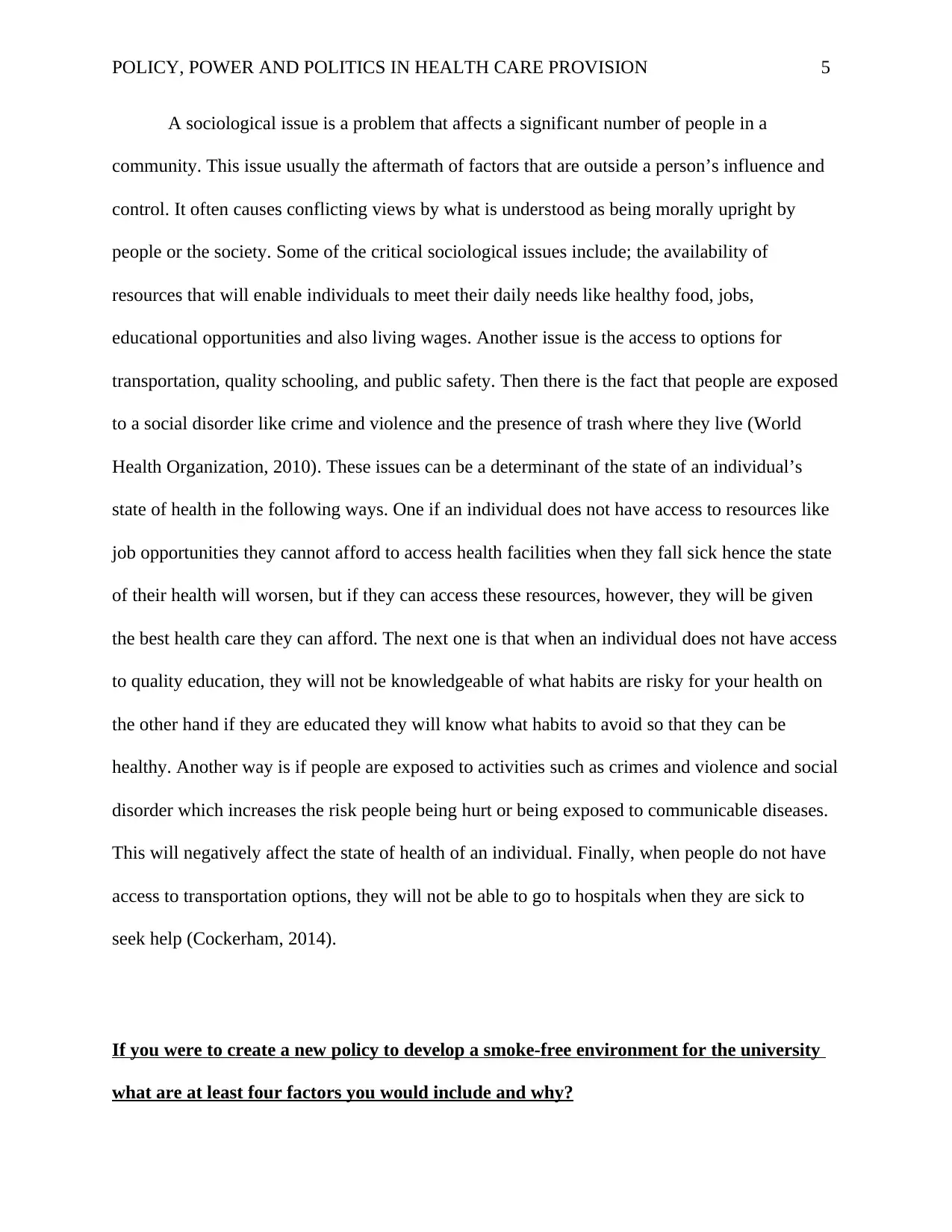
POLICY, POWER AND POLITICS IN HEALTH CARE PROVISION 5
A sociological issue is a problem that affects a significant number of people in a
community. This issue usually the aftermath of factors that are outside a person’s influence and
control. It often causes conflicting views by what is understood as being morally upright by
people or the society. Some of the critical sociological issues include; the availability of
resources that will enable individuals to meet their daily needs like healthy food, jobs,
educational opportunities and also living wages. Another issue is the access to options for
transportation, quality schooling, and public safety. Then there is the fact that people are exposed
to a social disorder like crime and violence and the presence of trash where they live (World
Health Organization, 2010). These issues can be a determinant of the state of an individual’s
state of health in the following ways. One if an individual does not have access to resources like
job opportunities they cannot afford to access health facilities when they fall sick hence the state
of their health will worsen, but if they can access these resources, however, they will be given
the best health care they can afford. The next one is that when an individual does not have access
to quality education, they will not be knowledgeable of what habits are risky for your health on
the other hand if they are educated they will know what habits to avoid so that they can be
healthy. Another way is if people are exposed to activities such as crimes and violence and social
disorder which increases the risk people being hurt or being exposed to communicable diseases.
This will negatively affect the state of health of an individual. Finally, when people do not have
access to transportation options, they will not be able to go to hospitals when they are sick to
seek help (Cockerham, 2014).
If you were to create a new policy to develop a smoke-free environment for the university
what are at least four factors you would include and why?
A sociological issue is a problem that affects a significant number of people in a
community. This issue usually the aftermath of factors that are outside a person’s influence and
control. It often causes conflicting views by what is understood as being morally upright by
people or the society. Some of the critical sociological issues include; the availability of
resources that will enable individuals to meet their daily needs like healthy food, jobs,
educational opportunities and also living wages. Another issue is the access to options for
transportation, quality schooling, and public safety. Then there is the fact that people are exposed
to a social disorder like crime and violence and the presence of trash where they live (World
Health Organization, 2010). These issues can be a determinant of the state of an individual’s
state of health in the following ways. One if an individual does not have access to resources like
job opportunities they cannot afford to access health facilities when they fall sick hence the state
of their health will worsen, but if they can access these resources, however, they will be given
the best health care they can afford. The next one is that when an individual does not have access
to quality education, they will not be knowledgeable of what habits are risky for your health on
the other hand if they are educated they will know what habits to avoid so that they can be
healthy. Another way is if people are exposed to activities such as crimes and violence and social
disorder which increases the risk people being hurt or being exposed to communicable diseases.
This will negatively affect the state of health of an individual. Finally, when people do not have
access to transportation options, they will not be able to go to hospitals when they are sick to
seek help (Cockerham, 2014).
If you were to create a new policy to develop a smoke-free environment for the university
what are at least four factors you would include and why?
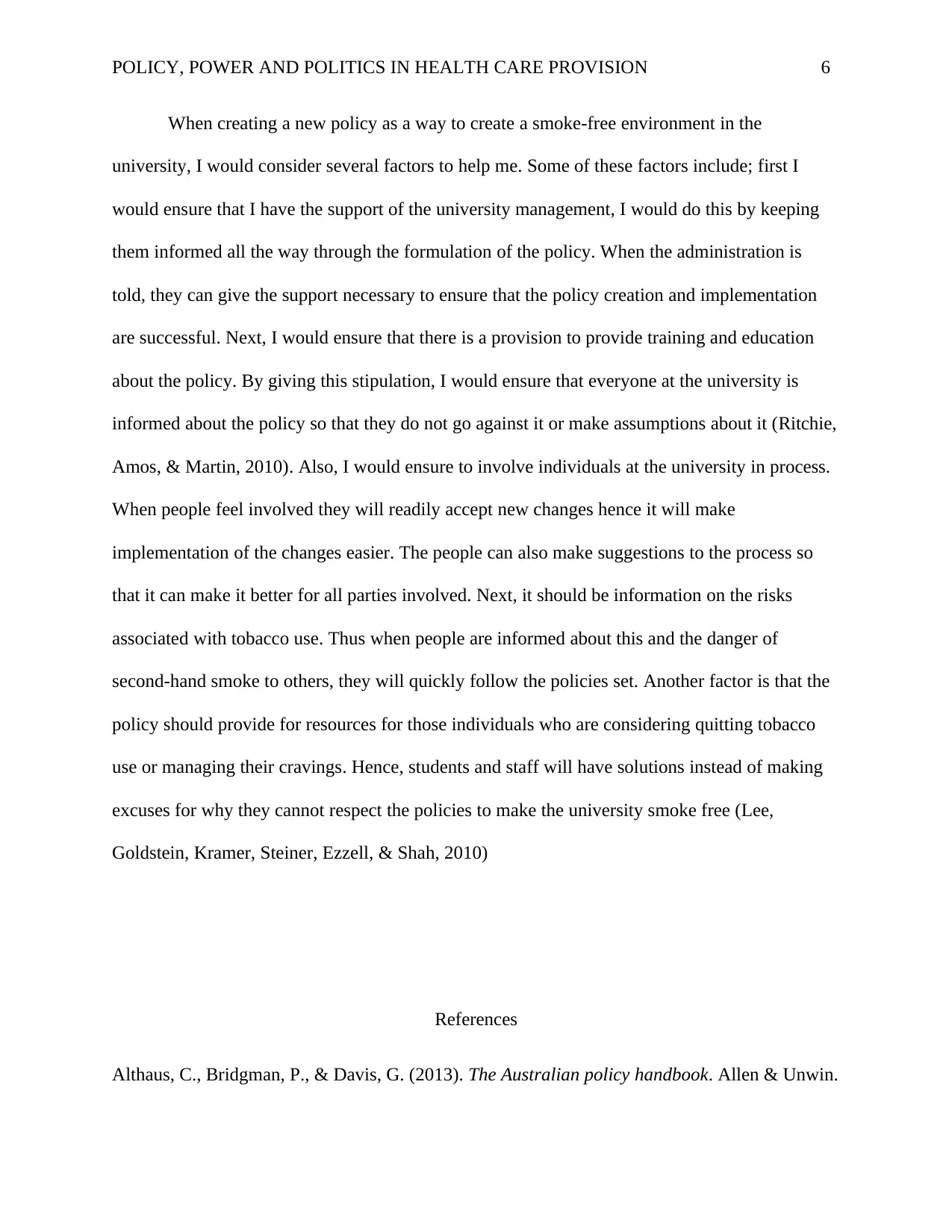
POLICY, POWER AND POLITICS IN HEALTH CARE PROVISION 6
When creating a new policy as a way to create a smoke-free environment in the
university, I would consider several factors to help me. Some of these factors include; first I
would ensure that I have the support of the university management, I would do this by keeping
them informed all the way through the formulation of the policy. When the administration is
told, they can give the support necessary to ensure that the policy creation and implementation
are successful. Next, I would ensure that there is a provision to provide training and education
about the policy. By giving this stipulation, I would ensure that everyone at the university is
informed about the policy so that they do not go against it or make assumptions about it (Ritchie,
Amos, & Martin, 2010). Also, I would ensure to involve individuals at the university in process.
When people feel involved they will readily accept new changes hence it will make
implementation of the changes easier. The people can also make suggestions to the process so
that it can make it better for all parties involved. Next, it should be information on the risks
associated with tobacco use. Thus when people are informed about this and the danger of
second-hand smoke to others, they will quickly follow the policies set. Another factor is that the
policy should provide for resources for those individuals who are considering quitting tobacco
use or managing their cravings. Hence, students and staff will have solutions instead of making
excuses for why they cannot respect the policies to make the university smoke free (Lee,
Goldstein, Kramer, Steiner, Ezzell, & Shah, 2010)
References
Althaus, C., Bridgman, P., & Davis, G. (2013). The Australian policy handbook. Allen & Unwin.
When creating a new policy as a way to create a smoke-free environment in the
university, I would consider several factors to help me. Some of these factors include; first I
would ensure that I have the support of the university management, I would do this by keeping
them informed all the way through the formulation of the policy. When the administration is
told, they can give the support necessary to ensure that the policy creation and implementation
are successful. Next, I would ensure that there is a provision to provide training and education
about the policy. By giving this stipulation, I would ensure that everyone at the university is
informed about the policy so that they do not go against it or make assumptions about it (Ritchie,
Amos, & Martin, 2010). Also, I would ensure to involve individuals at the university in process.
When people feel involved they will readily accept new changes hence it will make
implementation of the changes easier. The people can also make suggestions to the process so
that it can make it better for all parties involved. Next, it should be information on the risks
associated with tobacco use. Thus when people are informed about this and the danger of
second-hand smoke to others, they will quickly follow the policies set. Another factor is that the
policy should provide for resources for those individuals who are considering quitting tobacco
use or managing their cravings. Hence, students and staff will have solutions instead of making
excuses for why they cannot respect the policies to make the university smoke free (Lee,
Goldstein, Kramer, Steiner, Ezzell, & Shah, 2010)
References
Althaus, C., Bridgman, P., & Davis, G. (2013). The Australian policy handbook. Allen & Unwin.
⊘ This is a preview!⊘
Do you want full access?
Subscribe today to unlock all pages.

Trusted by 1+ million students worldwide
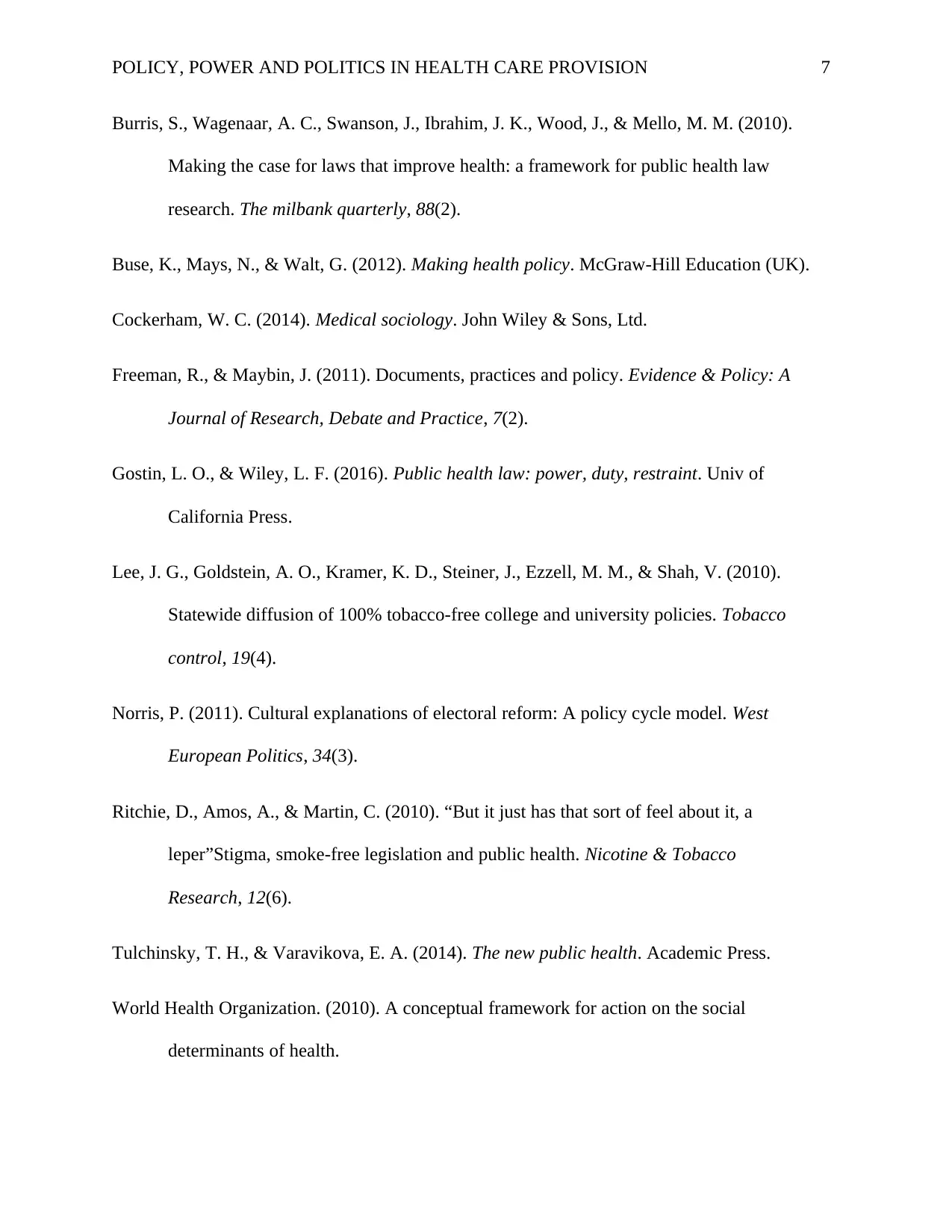
POLICY, POWER AND POLITICS IN HEALTH CARE PROVISION 7
Burris, S., Wagenaar, A. C., Swanson, J., Ibrahim, J. K., Wood, J., & Mello, M. M. (2010).
Making the case for laws that improve health: a framework for public health law
research. The milbank quarterly, 88(2).
Buse, K., Mays, N., & Walt, G. (2012). Making health policy. McGraw-Hill Education (UK).
Cockerham, W. C. (2014). Medical sociology. John Wiley & Sons, Ltd.
Freeman, R., & Maybin, J. (2011). Documents, practices and policy. Evidence & Policy: A
Journal of Research, Debate and Practice, 7(2).
Gostin, L. O., & Wiley, L. F. (2016). Public health law: power, duty, restraint. Univ of
California Press.
Lee, J. G., Goldstein, A. O., Kramer, K. D., Steiner, J., Ezzell, M. M., & Shah, V. (2010).
Statewide diffusion of 100% tobacco-free college and university policies. Tobacco
control, 19(4).
Norris, P. (2011). Cultural explanations of electoral reform: A policy cycle model. West
European Politics, 34(3).
Ritchie, D., Amos, A., & Martin, C. (2010). “But it just has that sort of feel about it, a
leper”Stigma, smoke-free legislation and public health. Nicotine & Tobacco
Research, 12(6).
Tulchinsky, T. H., & Varavikova, E. A. (2014). The new public health. Academic Press.
World Health Organization. (2010). A conceptual framework for action on the social
determinants of health.
Burris, S., Wagenaar, A. C., Swanson, J., Ibrahim, J. K., Wood, J., & Mello, M. M. (2010).
Making the case for laws that improve health: a framework for public health law
research. The milbank quarterly, 88(2).
Buse, K., Mays, N., & Walt, G. (2012). Making health policy. McGraw-Hill Education (UK).
Cockerham, W. C. (2014). Medical sociology. John Wiley & Sons, Ltd.
Freeman, R., & Maybin, J. (2011). Documents, practices and policy. Evidence & Policy: A
Journal of Research, Debate and Practice, 7(2).
Gostin, L. O., & Wiley, L. F. (2016). Public health law: power, duty, restraint. Univ of
California Press.
Lee, J. G., Goldstein, A. O., Kramer, K. D., Steiner, J., Ezzell, M. M., & Shah, V. (2010).
Statewide diffusion of 100% tobacco-free college and university policies. Tobacco
control, 19(4).
Norris, P. (2011). Cultural explanations of electoral reform: A policy cycle model. West
European Politics, 34(3).
Ritchie, D., Amos, A., & Martin, C. (2010). “But it just has that sort of feel about it, a
leper”Stigma, smoke-free legislation and public health. Nicotine & Tobacco
Research, 12(6).
Tulchinsky, T. H., & Varavikova, E. A. (2014). The new public health. Academic Press.
World Health Organization. (2010). A conceptual framework for action on the social
determinants of health.
Paraphrase This Document
Need a fresh take? Get an instant paraphrase of this document with our AI Paraphraser
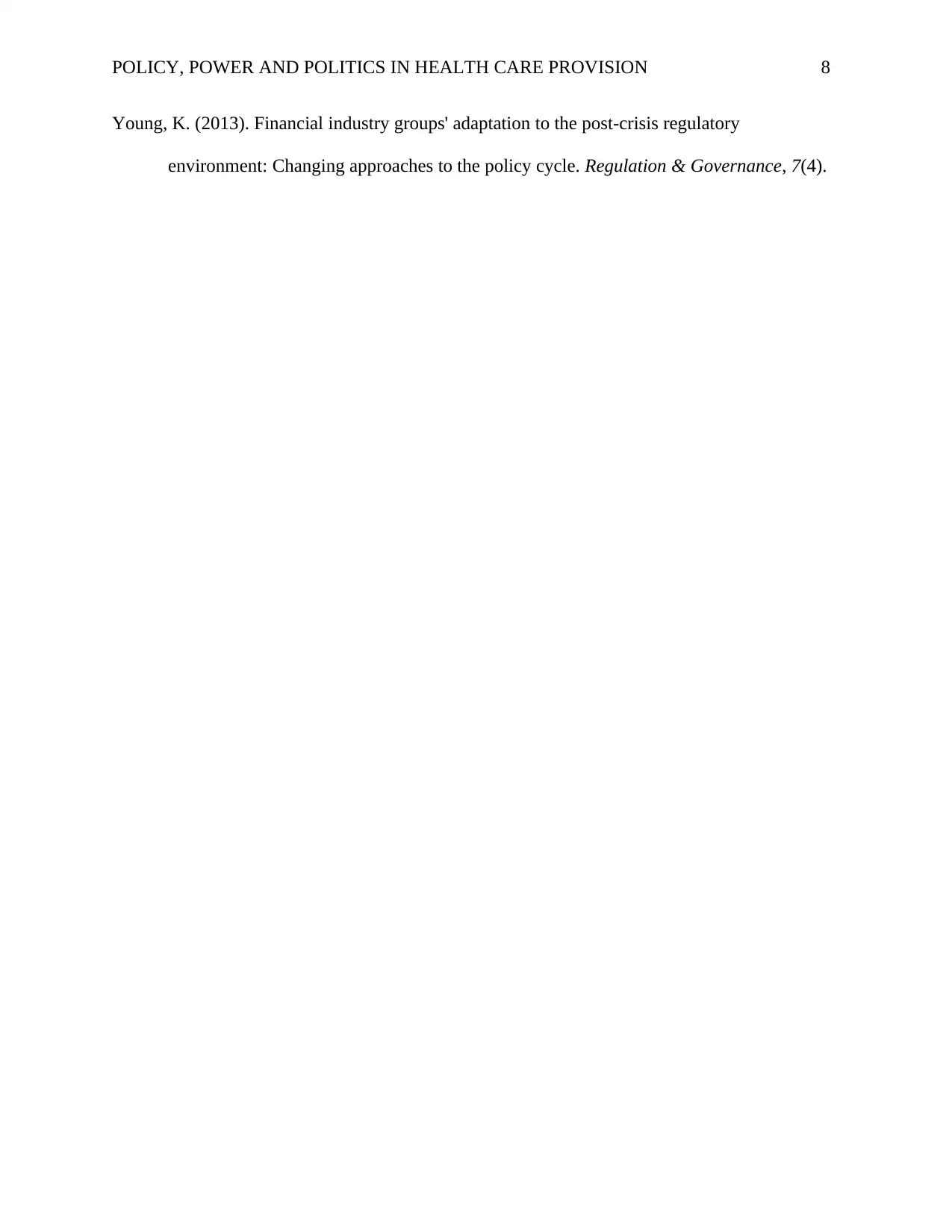
POLICY, POWER AND POLITICS IN HEALTH CARE PROVISION 8
Young, K. (2013). Financial industry groups' adaptation to the post‐crisis regulatory
environment: Changing approaches to the policy cycle. Regulation & Governance, 7(4).
Young, K. (2013). Financial industry groups' adaptation to the post‐crisis regulatory
environment: Changing approaches to the policy cycle. Regulation & Governance, 7(4).
1 out of 8
Related Documents
Your All-in-One AI-Powered Toolkit for Academic Success.
+13062052269
info@desklib.com
Available 24*7 on WhatsApp / Email
![[object Object]](/_next/static/media/star-bottom.7253800d.svg)
Unlock your academic potential
Copyright © 2020–2025 A2Z Services. All Rights Reserved. Developed and managed by ZUCOL.




